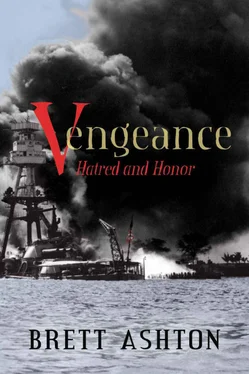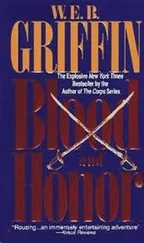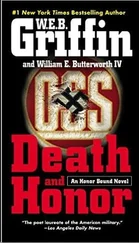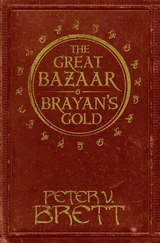Ships that were refloated for salvage operations had plenty of dead bodies on board which had to be removed and buried. Oil covered everything. The ships were full of tons and tons of rotten stores that stank to high heaven and had to be disposed of. Dead bodies and parts of bodies kept turning up around the harbor for months. The smell was everywhere and unbelievably foul. Wreckage accumulated in piles around the harbor from ships that had to be salvaged in a hurry. Tons of it had been cut from the tops of ships to help lighten them for refloating. The Arizona , Utah , and Okie were not going anywhere anytime soon, if at all.
If there was any doubt of the determination of the workers and survivors to continue in spite of it all, it died during that time. Sure, there was shock, plenty of it to be sure. Spirits were at an all-time low in some ways. How could this have happened to the great and mighty United States Pacific Fleet? But in spite of it all, everything that could be done was being done at an unbelievable pace.
By February of ’42, the Nevada had been refloated. The Pennsylvania , Tennessee , and Maryland were all stateside, being rebuilt. By March, the California was refloated and soon rebuilt. And by May, the West Virginia was refloated and being rebuilt. Most of the destroyers and cruisers damaged or destroyed in the attack had long been gone and getting overhauled as well. And none of them were being rebuilt to peace-time treaty specifications. I had the feeling the Japs would someday regret not sinking those ships while they were at sea where we wouldn’t have been able to salvage them, because they were being rearmed to the teeth.
The only holdouts were the Arizona , Oklahoma , and Utah , which remained right where they sank. The Utah and Oklahoma were still upside down, and the whole ship forward of the number two turret on the Arizona was, for all intents and purposes, no longer part of the ship.
The Utah was too old to worry about salvaging, but it had rolled out into the navigation lane and had to be moved. The Arizona was too damaged to worry about. And it didn’t look good that the Okie would be salvaged and returned to operation.
My thoughts any time I saw her as I worked around the harbor always turned to the four hundred plus members of the crew who were still inside her overturned hull, Ensign Flaherty being among them.
I knew a lot of them. The turrets were not easy to get out of in a hurry during an emergency, so a large portion of the crew who didn’t survive were those who worked on the lower decks of the turrets in the powder magazines. As a result, most of the Oklahoma ’s dead were under my command. And every time I saw the overturned hull of the Oklahoma , the anger I already felt just became that much more solid in me.
There was evidence that some of the crew trapped in the West Virginia had survived for as many as seventeen days after the attack. I thought of my own crew trapped, starving, and suffocating in the dark, wondering if anybody knew they were alive in there, wondering if they would be rescued, not knowing that any attempt to cut into the overturned hull would kill them anyway. Oil was inside and outside everywhere. Any cutting torch would have reignited the fires which took us days to put out.
There was nothing that could be done except to nurse our hatred for the Japanese and do everything we could do to hasten the day we would be able to pay them back. All you could really do was to stay busy and try not to think of the trapped and dying men you could not help.
The next few months flew by so fast for me that they seemed a blur. There was so much work to be done that even the most extreme effort seemed to yield only the smallest gain over the damage until you looked back on what you had done when you finished.
Then in April, the incredible happened. An aircraft carrier, the Hornet , left port with a most unusual cargo. B-25 bombers lined the flight deck. It was thought that they were just being moved to some forward island base or something, but that turned out not to be the case. It was the first strike back against the Japanese homeland. Doolittle’s Raid caused a celebration on the islands, which provided a fundamental change in attitude. All of a sudden, we knew we could hit them back.
For as low as our spirits were, we began to feel the absolute certainty that the Japs would pay for what they did, and our hatred for them began to propel us forward in ways that nobody would have thought possible a few months earlier.
It took weeks for the excitement of the Doolittle Raid on Tokyo to die down, but the attitude change we had experienced never shifted back. There was hope growing amidst the destruction now, and it could not be contained. Every sign of progress in the harbor began to stick to the hope that we would pay back the Japs in spades for what they did to us.
Then in July of ’42 something else happened that history doesn’t account for very well, at least not nearly as well as the raid over Tokyo. But nonetheless, it had a huge impact on the islands, not to mention my own personal life and career. There had been a great number of ships coming and going in the proceeding several months, some of them were beat up pretty bad. All of them were older ships that were the result of treaty limitations in the decades prior to the war: obsolete, under-powered, and under-armed. And while a lot of noticeable progress had been made in the cleanup, there was still a lot of destruction in the harbor.
I was working down at the hull of the overturned Utah with Commander Kenworthy, the Oklahoma ’s XO, when he tapped me on the shoulder and said, “Hey Jake, take a look at this.” A huge tower foremast like none we had ever seen appeared in the channel. Slowly, it circled Ford Island as we watched it. I still remember seeing it as the bow appeared around the buildings and other ships that blocked it from full view. Then gradually I saw the whole ship as it rounded the corner.
It had a gracefully swept deck, a heavily armored tower, and guns, guns, and more guns! Six sixteen-inch guns forward, followed by twenty five-inch guns mounted on ten double turrets, followed again by three more sixteen-inch guns. And every available other place on the deck was covered with one point one’s and fifty-caliber automatic weapons. She was huge compared to any other ship I’d ever seen except, of course, the carriers. And she was shiny and brand new, a stark contrast to the old oil- and rust-covered hodge podge patchwork of ships that were in the harbor at the time.
People these days talk about the Iowa class battleships in World War II, and understandably so, but the significant thing about this event is that they didn’t exist yet. There were no such things as nuclear submarines and super-carriers with jets or atom bombs or missiles or anything like that. So what you have to understand is what we were looking at in the Battleship North Carolina was, at the time, considered to be the most powerful weapon on Earth. And she was ours. She was quite a contrast there, amidst the destruction of Pearl Harbor,
She was Pearl Harbor’s beacon of hope, shining the light at the end of the tunnel just as the Tokyo Raid was a beacon of hope for the United States. She represented, more than ever, hope that we would come out of this war victorious.
I couldn’t help but notice a large number of personnel were gathering around the edge of Ford Island as well as on the mainland to get a view of this new behemoth battleship as she passed by. A surge of emotion swelled up among us in the harbor that was so strong people actually began to cheer and didn’t go back to work until she was parked at Pier 12.
Читать дальше












